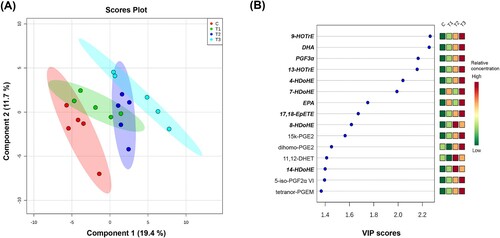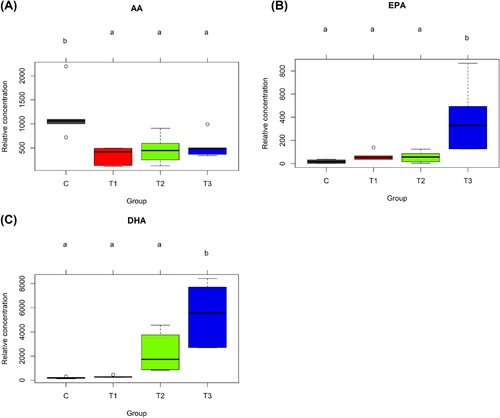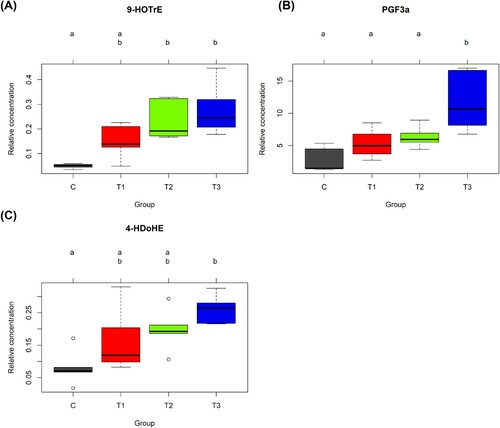Figures & data
Table 1. Nutrient composition of experimental diet.
Table 2. Fatty acid compositions of experimental diets.
Table 3. Fatty acid compositions of egg yolk samples at the end of the experimentTable Footnote1.
Figure 1. (A) Partial least squares discriminant analysis (PLS-DA) plot of lipid mediators obtained from the serum of laying hens fed 0, 0.9, 1.8 and 3.6% (w/w) flaxseed for 4 weeks. (B) Variable importance in projection (VIP) plot of 15 lipid mediators (VIP scores Top 15) that were differentially regulated among groups. C, 0% (w/w) flaxseed; T1, C + 0.9% (w/w) flaxseed; T2, C + 1.8% (w/w) flaxseed; T3, C + 3.6% (w/w) flaxseed. The colored boxes indicate the relative concentration of each group per lipid mediator. Lipid mediators whose relative concentrations were significantly differed among group are marked in bold italic (one-way ANOVA, P < 0.05).

Figure 2. Bar plots of relative concentrations of polyunsaturated fatty acids from the serum of laying hens fed 0, 0.9, 1.8 and 3.6% (w/w) flaxseed for 4 weeks. AA (A), EPA (B), and DHA (C) were determined in the sera of laying hens fed diets containing flaxseed for 4 weeks and measured by LC-MS/MS with 5 replicates per group. AA, arachidonic acid; EPA, eicosapentaenoic acid; DHA, docosahexaenoic acid; C, 0% (w/w) flaxseed; T1, C + 0.9% (w/w) flaxseed; T2, C + 1.8% (w/w) flaxseed; T3, C + 3.6% (w/w) flaxseed.

Figure 3. Bar plots of relative concentrations of lipid mediators from serum of laying hens fed 0, 0.9, 1.8 and 3.6% (w/w) flaxseed for 4 weeks. 9-HOTrE, ALA-derived lipid mediator (A), PGF3α, EPA-derived lipid mediator (B), and 4-HDoHE, DHA-derived lipid mediator (C) were determined in the sera of laying hens fed diets containing flaxseed for 4 weeks and measured by LC-MS/MS with 5 replicates per group. HOTrE, hydroxyoctadecatrienoic acid; PGF, prostaglandin F; HDoHE, hydroxydocosahexaenoic acid; C, 0% (w/w) flaxseed; T1, C + 0.9% (w/w) flaxseed; T2, C + 1.8% (w/w) flaxseed; T3, C + 3.6% (w/w) flaxseed.

Table 4. The levels of serum proinflammatory cytokine (TNF-alpha, IL-1beta and IL-6), serum corticosterone, and heterophil to lymphocyte ratio in experimental hens at week 0 and week 4Table Footnote1
Table 5. Effects of flaxseed in the diet on the performance and egg quality of laying hens during 33–37 weeks of ageTable Footnote1
